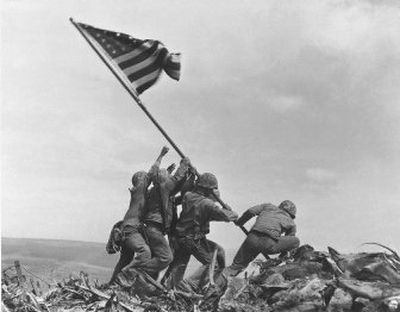Photographer Rosenthal dies

Joe Rosenthal – the Associated Press photographer whose dramatic picture of servicemen raising a giant, wind-whipped American flag atop Iwo Jima’s Mount Suribachi during World War II became an indelible image of courage and fortitude – has died. He was 94.
Rosenthal, who won a Pulitzer Prize in 1945 for his photograph, died Sunday morning at the Atria Tamalpais Creek assisted living facility in the northern California community of Novato.
Taken on Feb. 23, 1945, the photo of five Marines and a Navy corpsman marked the Marines’ costliest battle of the war. In the fierce fighting on the small island 750 miles south of Tokyo, 5,931 Marines died. The photo’s publication in newspapers across America helped instill pride and hope in Americans yearning for an end to the war.
Within months, the image had been engraved on a 3-cent stamp and emblazoned on 3.5 million posters and thousands of outdoor panels and car cards that helped sell more than $200 million in U.S. war bonds with the slogan, “Now All Together.” Navy artist Felix de Weldon recognized its symbolism and used the picture as a model to cast a small wax statue, a version of which would later be used to build the 32-foot-high bronze Marine memorial at Arlington National Cemetery outside Washington, D.C.
Long after the self-effacing Rosenthal had returned from the war and joined the San Francisco Chronicle, where he worked until his retirement in 1981, he was repeatedly interviewed about the picture that would secure his place in photographic history.
Many of the questions arose from the circumstances in which the photo was taken. As Rosenthal and everyone else involved in the picture knew, the image he captured was not of the initial flag-raising in which one group of Marines were involved but of the second flag-raising with a different set of servicemen.
When the congratulations came flowing in for the picture, he thought people were talking about what he called the “gung-ho” photo taken afterward, not the actual second flag-raising. So when someone asked him if he had set it up, he said, “Sure.” That comment was picked up and used as evidence that he had staged the flag-raising picture.
Rosenthal spent the rest of his life trying to correct the impression that his famed picture was manufactured, even after Robert Sherrod, the Time-Life correspondent who raised doubts with his editors in New York about the circumstances of the photograph, admitted he had made an error and that he “should have been more careful.”
Rosenthal was born Oct. 9, 1911, in Washington, D.C., one of five sons of Russian immigrants. After Pearl Harbor, he tried to enlist, but his vision was too impaired. He hooked up with the U.S. Maritime Service, and in 1944, the Associated Press offered him a chance to take photographs in the Pacific. He was at Guadalcanal, New Guinea and Guam before arriving in Iwo Jima, where the Marines were staging an assault in hopes of capturing the island, which was needed to support long-range bombers flying missions against key Japanese cities.
Rosenthal took modest pride in his famous photo.
“No photographer could have ever asked for a better break,” he told the Los Angeles Times in 1987. “The sun was just right. The wind was just right to flow the flag. The pipe – it must have weighed 100 pounds – was so heavy the guy holding it was struggling, typifying the struggle the Marines had in securing the island.”
Survivors include a daughter, Anne Rosenthal; a son, Joseph Rosenthal Jr.; and several grandchildren.